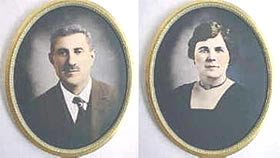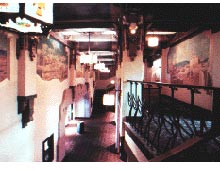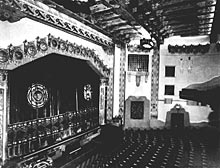History of The KiMo
Pueblo Deco was a flamboyant, short-lived architectural style that fused the spirit of the Native American cultures of the Southwest with the exuberance of Art Deco. Pueblo Deco appeared at a time when movie-mad communities were constructing film palaces based on exotic models such as Moorish mosques and Chinese pavilions.
Native American motifs appeared in only a handful of theaters; of those few, the KiMo is the undisputed king.
 Virtual Tour
Virtual Tour
Take a quick virtual tour of the historic KiMo Theatre, with the theater manager as your guide. From the recreation of the neon sign to the original projection booth, learn fun facts about the building and view historic photos you may have never seen before. Get an up-close look of this local treasure that has evolved alongside our ever-changing City. Once you Meet the KiMo, you'll Love the KiMo. (Virtual Tour).
 Founding Family
Founding Family
The genius behind the KiMo was Oreste Bachechi, a motivated entrepreneur from humble origins. Oreste Bachechi came to the United States in 1885 and set up a business in a tent near the railroad tracks in Albuquerque.
Bachechi's fortunes expanded with the city's growth; he became a liquor dealer and proprietor of a grocery store while his wife Maria ran a dry goods store in the Elms Hotel. By 1919, the Bachechi Amusement Association operated the Pastime Theatre with Joe Barnett. In 1925, Oreste Bachechi decided to achieve "an ambition, a dream that has been long in realization," by building his own theater, one that would stand out among the Greek temples and Chinese pavilions of contemporary movie mania.

Oreste and Maria Bachechi

KiMo Lobby

KiMo Stage, 1927
Bachechi envisioned a unique, Southwestern style theater, and hired Carl Boller of the Boller Brothers to design it. The Bollers had designed a Wild West-Rococo-style theater in San Antonio and a Spanish cathedral with Greco-Babylonian interior in St. Joseph, Missouri.
 Pueblo Influence
Pueblo Influence
Carl Boller traveled throughout New Mexico, visiting the pueblos of Acoma and Isleta, and the Navajo Nation. After months of research, Carl Boller submitted a watercolor rendering that pleased Oreste Bachechi.
The interior was to include plaster ceiling beams textured to look like logs and painted with dance and hunt scenes, air vents disguised as Navajo rugs, chandeliers shaped like war drums and Native American funeral canoes, wrought iron birds descending the stairs and rows of garlanded buffalo skulls with eerie, glowing amber eyes.
None of the designs were chosen at random. Each of the myriad images of rain clouds, birds and swastikas had historical significance. The Navajo swastika is a symbol for life, freedom and happiness.
Like its abstract symbols, color, too, was part of the Indian vocabulary. Yellow represents the life-giving sun, white the approaching morning, red the setting sun of the West and black the darkening clouds from the North. The crowning touch was the nine large wall murals painted in oil by Carl Von Hassler. Working from 20 foot high scaffolding, Von Hassler spent months on his creations.
The theater, which cost $150,000, was completed in less than a year. The elaborate Wurlitzer pipe organ that accompanied the silent films of the day was an extra $18,000.
 Opening Night
Opening Night
On opening night, an overflow crowd watched performances by representatives from nearby Indian pueblos and reservations. The performers, reported the New Mexico State Tribune in an advance story, included "numerous prominent tribesman of the Southwest who will perform for the audience mystic rites never before seen on the stage."
 Route 66 History Trivia
Route 66 History Trivia
Prior to 1937, Route 66 passed through Albuquerque from north to south on what is now 4th Street.
In 1937 the Highway was realigned east to west along Central Avenue. The KiMo is located at 5th Street and Central.
 Native Language - detail
Native Language - detail
The name KiMo is commonly pronounced with a hard 'K' sound for the first letter and an 'ee' sound for the letter "i". However it is more correctly pronounced with a soft 'k', more like a short 'H' and a short 'i' as in 'is'. ( him-o ) Due to the use of the name outside it's native Tiwa culture it is now a 'dead' word and is no longer used by native speakers.
Isleta Pueblo Governor Pablo Abeita won a prize of $50, a magnificent sum for the time, for naming the new theater. Reflecting the optimism of the time, "KiMo," is a combination of two Tiwa words meaning "mountain lion" but liberally interpreted as "king of its kind".
Vivian Vance, who gained fame as Lucille Ball's sidekick in the "I Love Lucy" series, performed at the KiMo. The theater also hosted such stars as Sally Rand, Gloria Swanson, Tom Mix and Ginger Rogers. When the theater was packed, the balcony—which spans the east to west walls without support and was designed to give and sway—would drop four to eight inches in the middle.
A year after the realization of his dream, Oreste Bachechi died, leaving the management of the KiMo to his sons, who combined vaudeville and out-of-town road shows with movies. Extra revenue came in from a luncheonette and curio shop on either side of the entrance. In later years, the Kiva-Hi, second floor restaurant, and KGGM radio, housed on the second and third floors, were major tenants.
 Preserving a Treasure
Preserving a Treasure
A large fire in the early 1960's nearly destroyed the stage and severely damaged adjacent areas at the front of the auditorium. The KiMo fell into further disrepair following the exodus from downtown that so many American cities experienced in the 60's and 70's. Slated for destruction, the KiMo was saved in 1977 when the citizens of Albuquerque voted to purchase this unrivaled palace.
 Restoration of the KiMo
Restoration of the KiMo
Read more about restoration of the KiMo.
Edited by John Arnold, New Mexico Museum of Natural History, with information provided by the KiMo Theatre.
